This is the third part of the 5-episode series on travel through Pakistan by national highway N5. Our idea is to introduce smaller cities and towns while skipping the introduction of bigger cities enroute as most people already know about them and they are also covered separately at ATP. Today we will start our journey from Bahawalpur and by the end of this post we will reach Lahore.
See the map below which shows our proposed journey today. Bahawalpur is at lower left and Lahore at upper right.
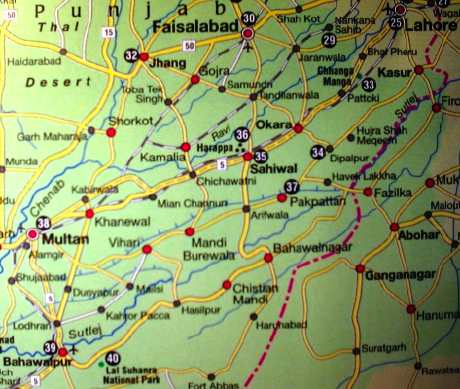
Lodhran (N5 Km marker 860)
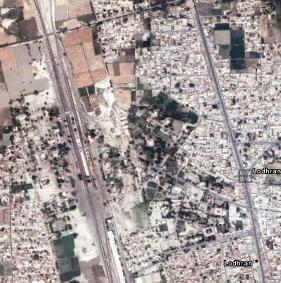 Lodhran is somehow more popular as being an important Railway junction than a city on N5. It is the junction city where main Karachi – Peshawar railway line branches off to Multan and then reach Khanewal (via Loop) or continue via Jahania to Khanewal (via Chord).
Lodhran is somehow more popular as being an important Railway junction than a city on N5. It is the junction city where main Karachi – Peshawar railway line branches off to Multan and then reach Khanewal (via Loop) or continue via Jahania to Khanewal (via Chord).
.. the satellite image to the left shows Lodhran city. The grayish line towards the right of the photo shows highway N5 passing through the city. Railway line is also visible towards left ..
Lodhran is a very fertile land and it is famous for cotton production.
Shah Naal (N5 km marker 872)
Jella Arian (N5 km marker 883)
Basti Maluk (N5 km marker 896)
Lar (N5 km marker 915)
Multan (N5 km marker 937)
Multan has been covered in detail at ATP in following articles, so instead of writing something new I will give links to these fine articles.
- The Gateways of Multan by S.A.J Shirazi, and
- The Saints and Shrines of Multan by Roshan Malik
Khanewal (N5 km marker 980)
 Khanewal is named after the earliest settelers here who belonged to the clan ‘Daha’ and used the word ‘khan’ in their names. That is how the city came to be known as ‘khan-e-wal’.
Khanewal is named after the earliest settelers here who belonged to the clan ‘Daha’ and used the word ‘khan’ in their names. That is how the city came to be known as ‘khan-e-wal’.
.. Photo to the right is a cropped image of Khanewal signboard at Khanewal Railway Station ..
Khanewal is also one of the most important junctions on Pakistan Railway’s network.
Musa Virk (N5 km marker 1020)
Mian Channu (N5 km marker 1026)
 Mian Channu is famous for its agricultural equipment industry as well as the area around te city is very fertile for wheat and cotton production.
Mian Channu is famous for its agricultural equipment industry as well as the area around te city is very fertile for wheat and cotton production.
.. photo to the left shows a Mian Channu secondary School building ..
 Another speciality of the city is particular form of sweet which is called khushi Barfi. Mian Channu is also home to politician and aristocracy therefore one can see grand ‘haveli’ style buildings in the city.
Another speciality of the city is particular form of sweet which is called khushi Barfi. Mian Channu is also home to politician and aristocracy therefore one can see grand ‘haveli’ style buildings in the city.
.. Photo to the right shows, Jinnah Hall, Mian Channu..
Former Chief Minister of Punjab, late Ghulam Haider Wain hailed from Mian Channu. Compere Tariq Aziz of ‘neelam ghar’ fame also did his early education from Mian Channu.
Harappa (N5 km marker 1082)
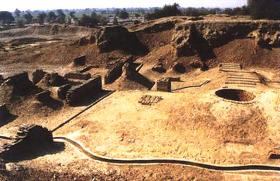 Harappa was discovered in the mid nineteenth century by the Railway engineers building the Multan – Lahore railway line. They found hundreds and thousands of bricks lying around in Harappa ruins and used them as a convenient ballast to lay the railway tracks over. That is why sometimes it is said that foundations of Multan – Lahore track are 5000 years old. The railway engineers had no idea that by taking bricks out of Harappa site they were destroying the remains of an ancient civilization contemporaneous with Babylon, Ur, and the Egyptian pyramids.
Harappa was discovered in the mid nineteenth century by the Railway engineers building the Multan – Lahore railway line. They found hundreds and thousands of bricks lying around in Harappa ruins and used them as a convenient ballast to lay the railway tracks over. That is why sometimes it is said that foundations of Multan – Lahore track are 5000 years old. The railway engineers had no idea that by taking bricks out of Harappa site they were destroying the remains of an ancient civilization contemporaneous with Babylon, Ur, and the Egyptian pyramids.
The site at Harappa was first briefly excavated by Sir Alexander Cunningham in 1872-73, two decades after brick robbers carried off the visible remains of the city. He found an Indus seal of unknown origin.
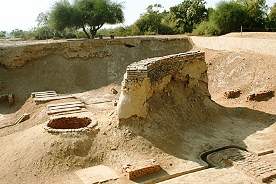 The first extensive excavations at Harappa were started by Rai Bahadur Daya Ram Sahni in 1920. His work and contemporaneous excavations at Mohenjo-daro first brought to the world’s attention the existence of the forgotten Indus Valley civilization as the earliest urban culture in the Indian subcontinent. His work was followed later in the decade by that of Madho Sarup Vats, also of the Archaeological Survey of India. Excavations by other archaeologists continued in the 1930’s, and in 1946 Sir Mortimer Wheeler excavated the so-called fortification walls and found the first pre-Indus Valley civilization (Kot Dijian) deposits. After independence in 1947 and coming in District Sahiwal of Province of Punjab, Pakistan, Harappa was excavated by Mohammed Rafique Mughal of the Archaeological Survey of Pakistan in 1966.
The first extensive excavations at Harappa were started by Rai Bahadur Daya Ram Sahni in 1920. His work and contemporaneous excavations at Mohenjo-daro first brought to the world’s attention the existence of the forgotten Indus Valley civilization as the earliest urban culture in the Indian subcontinent. His work was followed later in the decade by that of Madho Sarup Vats, also of the Archaeological Survey of India. Excavations by other archaeologists continued in the 1930’s, and in 1946 Sir Mortimer Wheeler excavated the so-called fortification walls and found the first pre-Indus Valley civilization (Kot Dijian) deposits. After independence in 1947 and coming in District Sahiwal of Province of Punjab, Pakistan, Harappa was excavated by Mohammed Rafique Mughal of the Archaeological Survey of Pakistan in 1966.
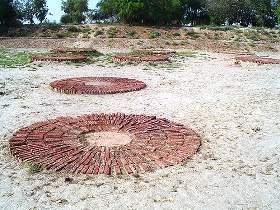 In 1986, the first systematic, multi-disciplinary excavations of an Indus Valley city were begun by the Harappa Archaeological Project (HARP), under the direction of George F. Dales and Jonathan Mark Kenoyer.
In 1986, the first systematic, multi-disciplinary excavations of an Indus Valley city were begun by the Harappa Archaeological Project (HARP), under the direction of George F. Dales and Jonathan Mark Kenoyer.
Along with Moen-jo-Daro, Harappa in one of the most important archeological site of Indus Valley civilization in Pakistan. It is somewhat less complete than Moen-jo-Daro, though most of the features of Moen-jo-Daro can be found here as well and excavations are still continuing. 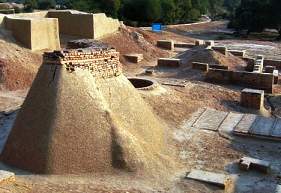 Of particular interest is the so-called cemetery H, whose painted burial urns provide fascinating clues as to the beliefs of the makers. Common motifs found here include peacocks, bulls and cows.
Of particular interest is the so-called cemetery H, whose painted burial urns provide fascinating clues as to the beliefs of the makers. Common motifs found here include peacocks, bulls and cows.
Although there is a good museum in Harappa, walking around the ruins is an exercise in confusion. Originally, the city stretched roughly one kilometer to the east of its citadel, but almost everything has been erased. Really all that’s survived the ravages of time and railway conractors is the area between the citadel and the old bed of river Ravi, which has since moved 8 kilometers eastward.
Sahiwal (N5 km marker 1102)
Sahiwal’s former name was Montgommery which was named after the then Leutenant Governer of Punjab Sir Robert Montgommery. It started as a small canal colony in 1865 today it has grown up into a relatively modern town with lots of industrial development. The city got its current name Sahiwal in 1966.
Sahiwal is also very famous a breed of cows which is considered the best dairy breed of zebu or humped cattle (Bos indicus). Sahiwal breed of cows was exported to Australia via New Guinea in the early 1950’s. In Australia it played a valuable role in the development of the two Australian tropical dairy breeds, the Australian milking zebu and the Australian Fresian Sahiwal. Sahiwal breeds are now predominantly used in Australia for beef production.
Sahiwal also has a very famous District Jail. It is one of the ancient jails in Punjab. It was depicted in one of the famous Pakistan Television Corporation (PTV) drama Jangloos. Famous Urdu poet Faiz Ahmad Faiz wrote a major part of his poetry while he was in Sahiwal Jail as a political prisoner.
Are we there yet?
So far we have covered 240km since we left Bahawalpur. This may be a good time for a short break and take a look at big picture of N5 highway. Following two maps show how much journey is completed and how much more is left before this post ends.
Covered: Bahawalpur to Sahiwal via Lodhran and Multan
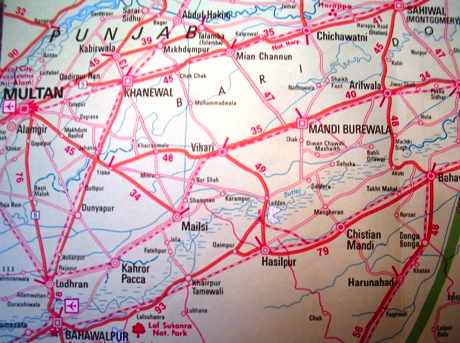
To be covered: Sahiwal to Lahore
And following map shows what we still have to cover before the end of this post.
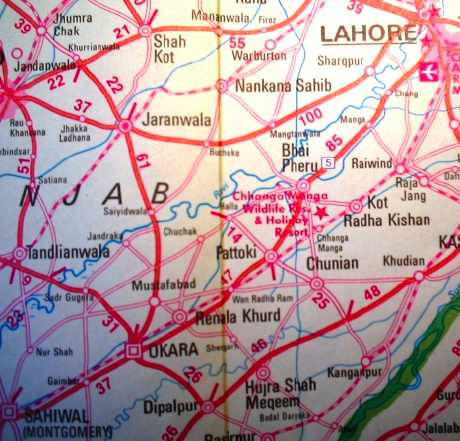
Let us now resume our journey just north of Sahiwal and travel towards Okara.
Qadirabad (N5 km marker 1114)
Okara (N5 km marker 1134)
It is said that in the area which comprises of Okara city now, there was once a big collection of ‘okaaN’ trees and that is how the city got its name Okara.
Photo below is a satellite image of Okara City. N5 bypass of the city is visible towards the right half of the city. N5 business loop as well as the railway line pass through the city as parallel diagonal lines visible in the photo.
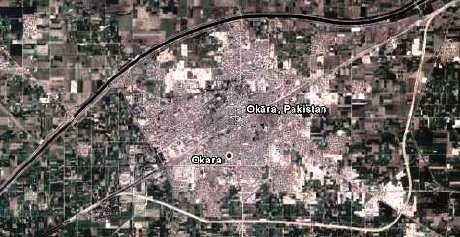
Renala Khurd (N5 km marker 1151)
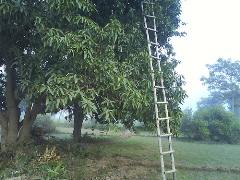 This city was established in 1914 when canal lower bari do-aab passed throuh this region. In 1925 a hydel power station was built in Renala Khurd which is still functional. Renala Khurd’s old name was Malah Wala because of the presence of ‘Malah’ trees in the area. It quicky grew as a canal colony and a food stock market called ‘ghalla mandi’ was established here in 1940.
This city was established in 1914 when canal lower bari do-aab passed throuh this region. In 1925 a hydel power station was built in Renala Khurd which is still functional. Renala Khurd’s old name was Malah Wala because of the presence of ‘Malah’ trees in the area. It quicky grew as a canal colony and a food stock market called ‘ghalla mandi’ was established here in 1940.
Renala Khurd is famous for the farms of Mitchells industries. Their jams, jellies and ketchup are famous.
Akhtarabad (N5 km marker 1161)
Wan Radharam (N5 km marker 1168)
Pattoki (N5 km marker 1180)
Pattoki is called Pakistan’s mini Holland for its flower industry. It was covered earlier in a very informative article written by S.A.J Shirazi as The Petals of Pattoki
Following video clip is by Raju Jameel and it gives a glimpse and commentary about beautiful flower nurseries that adorn both sides of N5 near Pattoki.
Bhai Pheru (N5 km marker 1204)
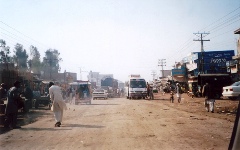 The name Bhai Pheru is named after a sikh. It is said that Bhai Pheru was a person who served the 9th Sikh Guru named Guru Tegh Bahadur in one of his travels. I am not sure how the city in Pakistani Punjab came to be known as Bhai Pheru but this is the closest reference to its name that I found.
The name Bhai Pheru is named after a sikh. It is said that Bhai Pheru was a person who served the 9th Sikh Guru named Guru Tegh Bahadur in one of his travels. I am not sure how the city in Pakistani Punjab came to be known as Bhai Pheru but this is the closest reference to its name that I found.
.. The photo shows main bazar of Bhai Pheru ..
Manga (N5 km marker 1220)
Chung (N5 km marker 1239)
Lahore (N5 km marker 1260)
Lahore has been widely covered in following articles which have appeared at ATP therefore I’ll not give a separate introduction to the city here.
- Lahore Lahore aye by Raza Noor
- The Public Sculptures of Historic Lahore by Raza Rumi
- Lawrence Gardens, Lahore by Raza Rumi
- Battling the Smog, Fog and Haze in Lahore by S.A.J. Shirazi
- The Unique Driving Rules of Lahore by S.A.J. Shirazi
- Lahore Rapid Mass Transit Rail Project by Owais Mughal
Following are the distances of various cities in alphabetical order on N5 from Lahore:
Lahore to Bahawalpur: 416 km
Lahore to Gujranwala: 68 km
Lahore to Gujrat: 120 km
Lahore to Hasan Abdal: 325 km
Lahore to Hyderabad: 1097 km
Lahore to Jhelum: 172 km
Lahore to Karachi: 1260 km
Lahore to Khanewal: 280 km
Lahore to Landi Kotal: 490 km
Lahore to Multan: 323 km
Lahore to Nowshera: 397 km
Lahore to Okara: 126 km
Lahore to Peshawar: 440 km
Lahore to Rahimyar Khan: 605 km
Lahore to Rawalpindi: 280 km
Lahore to Rohri: 777 km
Lahore to Sadiqabad: 623 km
Lahore to Sahiwal: 158 km
Lahore to Taxila: 309 km
Lahore to Wazirabad: 102 km
Following are distances of various cities From Lahore located on N65 (Sukkur-Quetta) highway:
Lahore to Sukkur: 782 km
Lahore to Shikarpur: 819 km
Lahore to Jacobabad: 861 km
Lahore to Sibi: 1019 km
Lahore to Quetta: 1167 km
ATP brings you the Complete Story of Travel on N5:
1. Traveling on N5 – I: Karachi to Rohri: 483 km
2. Traveling on N5 – II: Rohri to Bahawalpur: 361 km
3. Traveling on N5 – III: Bahawalpur to Lahore: 417 km
4. Traveling on N5 – IV: Lahore to Rawalpindi: 272 km
5. Traveling on N5 – V: Rawalpindi to Torkham: 216 km
Also see
1. Sukkur to Quetta by Highway N65



















































dear respondent i wana know distance in between
sadiqabad to Harappa
Guddu Barrage to Harappa
can u send me the political map of bahawalnagar dist. there is my elders village ‘nilianwala’. they lived there before 1947. i want to see adject location bcoz we want to see it through google earth. specialy my dada ji who spent his jawani there. we will be thankfull
i live i USA right now can u send me a more pix of okara
pls
Dear Tariq Mahmood. Following are distances of various cities From Lahore located on N65 (Sukkur-Quetta) highway
Sukkur: 782 km
Shikarpur: 819 km
Jacobabad: 861 km
Sibi: 1019 km
Quetta: 1167 km
Dear Tariq Mahmood. Following are distances of various cities from Lahore via Motorway Network
Faisalabad: 162 km (110 km on M2 and 52 km on M3)
Islamabad: 370 km by M2
Sargodha: ~200 km (162 km on M2 and 40+ km on a side road)
Peshawar: 545 km (370 km on M2 and 175 km on M1)